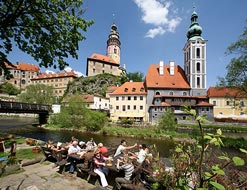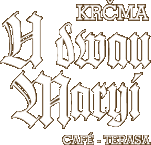The House „U dwau Maryí“ („At two Maries“)
 Similar to many other houses in the town, this house was built between two town walls - in the so called roundabout moat. This happened in the interior town during the late Middle Ages. The town square is the natural core of the town situated among the curves of the river Vltava.
Similar to many other houses in the town, this house was built between two town walls - in the so called roundabout moat. This happened in the interior town during the late Middle Ages. The town square is the natural core of the town situated among the curves of the river Vltava.
Originally, a one storey house connected with the rundabout wall at its interior side used to stand here. An Entry room with a fire - place was obviously incorporated into the one storey vault. The first floor was probably built then too. A lounge with picturesquely decorated ceiling of boards can be found there.
Later, the house was extended by a super - structure on the exterior side of the rundabout wall and a few openings were made into the wall. A meter thick fortification wall can still be found in the interior of the house.
Plaster coating in Renaissance style has been preserved under the present baroque facade of the house.
Two wall paintings representing the Virgin Mary on the facade were discovered during restoration in 1950. The first painting of St. Mary situated between the windows on the first floor is younger. It was created in the second half of the 18th century.
The lower picture, which has been preserved just in outlines and only with fragments of its original colours, dates back to 1714. The inhabitans of the house asked Virgin Mary for protection in the incomplete German title belonging to the picture. An older Renaissance painting was discovered under paintig of Mary in the first floor.
The tavern „U dwau Maryi“ was opened in 1990. In this way we try to recreate the atmosphere of the past in the carefully renovated rooms. Historic materials that would be otherwise destroyed or thrown away in the dump were reused for the equipment of the tavern. For example, there are bricks from the loft the of another house in Krumlov, the beams for bar and the terrace were taken from broken rafters in the near town of Frymburk, the tops of the tables and the benches were made from a baroque board ceiling, the flat stones on the terrace used to be part of the original sewer in Krumlov.
The decorative objects made with the skill of the ancient smiths were found mostly on tips, dumps or in litter containers.



